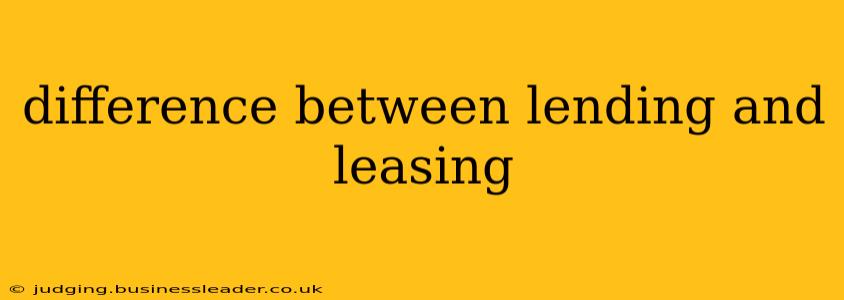Lending vs. Leasing: Understanding the Key Differences
Choosing between lending and leasing depends heavily on your individual circumstances and financial goals. Both options offer ways to acquire the use of an asset, whether it's a car, equipment, or even real estate, but they differ significantly in terms of ownership, responsibility, and long-term costs. This comprehensive guide will clarify the key distinctions between lending and leasing, helping you make an informed decision.
What is Lending?
Lending involves borrowing money from a lender (like a bank or credit union) to purchase an asset outright. You become the owner of the asset, responsible for all maintenance, repairs, and insurance. The lender secures the loan against the asset, meaning they can repossess it if you default on the loan payments.
Key Characteristics of Lending:
- Ownership: You own the asset outright upon completion of loan payments.
- Responsibility: You are responsible for all maintenance, repairs, insurance, and taxes.
- Flexibility: You can sell, modify, or dispose of the asset as you see fit.
- Long-term cost: Generally higher upfront costs, but lower overall cost in the long run due to eventual ownership.
What is Leasing?
Leasing involves renting an asset for a specified period. You make regular payments to the lessor (the owner of the asset) for the right to use it, but you do not own it. At the end of the lease term, you typically return the asset or have the option to purchase it.
Key Characteristics of Leasing:
- Ownership: You do not own the asset; you only have the right to use it.
- Responsibility: The lessor is typically responsible for major repairs and maintenance (though this can vary depending on the lease agreement). You are responsible for regular maintenance and insurance as outlined in the lease.
- Flexibility: Less flexibility compared to lending; you are bound by the terms of the lease agreement.
- Long-term cost: Lower upfront costs, but potentially higher overall costs due to ongoing payments and the inability to build equity.
What are the Pros and Cons of Lending?
Pros:
- Ownership: You build equity in the asset and eventually own it outright.
- Flexibility: You have complete control over the asset and can sell it whenever you want.
- Long-term savings: In the long run, the total cost is usually lower than leasing.
Cons:
- Higher upfront costs: Requires a significant down payment and potentially higher interest rates.
- Greater responsibility: You are responsible for all maintenance, repairs, and insurance.
- Depreciation: The value of the asset depreciates over time.
What are the Pros and Cons of Leasing?
Pros:
- Lower upfront costs: Typically requires a smaller down payment or security deposit.
- Lower monthly payments: Monthly payments are generally lower than loan payments.
- Regular maintenance: The lessor often handles major repairs and maintenance.
Cons:
- No ownership: You do not own the asset at the end of the lease term.
- Mileage and usage restrictions: Leases often have limitations on mileage and usage.
- Higher long-term cost: The total cost over the lease term can be higher than purchasing with a loan.
What are the common types of leases?
There are various types of leases, each with its own nuances. These include operating leases (short-term, typically for equipment), financial leases (longer-term, often treated as financing), and sale and leaseback agreements (where an owner sells an asset and then leases it back). Understanding the specific type of lease is crucial to comprehending its implications.
Which is better for me: Lending or Leasing?
The "better" option depends entirely on your individual needs and financial situation. Consider these factors:
- Your budget: Do you have the funds for a large down payment?
- Your long-term goals: Do you plan to keep the asset for a long time?
- Your risk tolerance: Are you comfortable with the responsibilities of ownership?
- The type of asset: Some assets are better suited for leasing (e.g., vehicles with rapidly depreciating value), while others make more sense to own (e.g., property).
By carefully weighing the pros and cons of each option and considering your individual circumstances, you can determine whether lending or leasing is the best choice for you. Remember to carefully review all terms and conditions before making a decision.
